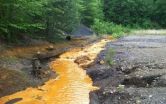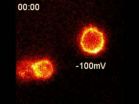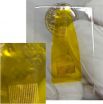(Press-News.org) Scientists have developed new geochemical tracers that can identify hydraulic fracturing flowback fluids that have been spilled or released into the environment.
The tracers have been field-tested at a spill site in West Virginia and downstream from an oil and gas brine wastewater treatment plant in Pennsylvania.
"By characterizing the isotopic and geochemical fingerprints of enriched boron and lithium in flowback water from hydraulic fracturing, we can now track the presence of 'frac' fluids in the environment and distinguish them from wastewater coming from other sources, including conventional oil and gas wells," said Duke University geochemist Avner Vengosh, who co-led the research.
"This gives us new forensic tools to detect if frac fluids are escaping into our water supply and what risks, if any, they might pose."
Using the tracers, scientists can determine where frac fluid contamination has--or hasn't--been released to the environment and, ultimately, help identify ways to improve how shale gas wastewater is treated and disposed of.
The researchers published their findings today in the journal Environmental Science & Technology. Their study, which was funded by the National Science Foundation (NSF), is the first to report on the development of the boron and lithium tracers.
"With increasing exploitation of unconventional oil and gas reservoirs through the use of hydraulic fracturing, it's important that we are able to assess the extent of hydraulic fracturing fluids entering the environment," said Alex Isern, section head in NSF's Division of Earth Sciences, which funded the research.
"This work is critical as it demonstrates that geochemical fingerprinting provides a powerful tool to differentiate potential sources of contamination and therefore guide efforts to mitigate environmental impacts."
Adds Nathaniel Warner of Dartmouth College, lead author of the paper, "This new technology can be combined with other methods to identify specific instances of accidental releases to surface waters in areas of unconventional drilling.
"It could benefit industry as well as federal and state agencies charged with monitoring water quality and protecting the environment."
Hydraulic fracturing fluids--or frac fluids--typically contain mixes of water, proprietary chemicals and sand. Mixtures can vary from site to site.
Drillers inject large volumes of the fluids down gas wells at high pressure to crack open shale formations deep underground and allow natural gas trapped within the shale to flow out and be extracted.
After the shale has been fractured, the frac fluids flow back up the well to the surface along with the gas and highly saline brines from the shale formation.
Some people fear that toxic frac fluid chemicals in this flowback could contaminate nearby water supplies if they're accidentally spilled or insufficiently treated before being disposed of.
"The flowback fluid that returns to the surface becomes a waste that needs to be managed," Vengosh explained.
"Deep-well injection is the preferable disposal method, but injecting large volumes of wastewater into deep wells can cause earthquakes in sensitive areas and is not geologically available in some states.
"In Pennsylvania, much of the flowback is now recycled and reused, but a significant amount of it is still discharged into local streams or rivers."
It's possible to identify the presence of frac fluid in spilled or discharged flowback by tracing synthetic organic compounds that are added to the fluid before it's injected down a well, Vengosh said, but the proprietary nature of these chemicals, combined with their instability in the environment, limits the usefulness of such tracers.
By contrast, the new boron and lithium tracers remain stable in the environment.
"The difference is that we are using tracers based on elements that occur naturally in shale formations," Vengosh said.
When drillers inject frac fluids into a shale formation, they not only release hydrocarbon, but also boron and lithium that are attached to clay minerals in the formation.
As the fluids react and mix at depth, they become enriched in boron and lithium.
As they're brought back to the surface, they have distinctive fingerprints that are different from other types of wastewater, including wastewater from a conventional gas or oil well, and from naturally occurring background water.
"This type of forensic research allows us to clearly identify possible sources of wastewater contamination," Vengosh said.
INFORMATION:
Thomas Darrah of The Ohio State University, Robert Jackson of Duke and Stanford Universities and Romain Millot and Wolfram Kloppmann of the French Geological Survey also co-authored the paper, which was partly funded by the Park Foundation.
LIVERMORE, Calif. – New medications created by pharmaceutical companies have helped millions of Americans alleviate pain and suffering from their medical conditions. However, the drug creation process often misses many side effects that kill at least 100,000 patients a year, according to the journal Nature.
Lawrence Livermore National Laboratory researchers have discovered a high-tech method of using supercomputers to identify proteins that cause medications to have certain adverse drug reactions (ADR) or side effects. They are using high-performance computers ...
Preexisting differences in the sensitivity of a key part of each individual's immune system to stress confer a greater risk of developing stress-related depression or anxiety, according to a study conducted at the Icahn School of Medicine at Mount Sinai and published October 20 in the Proceedings of the National Academy of Sciences (PNAS).
Inflammation is the immune system's response to infection or disease, and has long been linked to stress. Previous studies have found depression and anxiety to be associated with elevated blood levels of inflammatory molecules ...
CHAMPAIGN, Ill. — They help fish swim, but fins also advertise a fish's social standing and health. In a new study, researchers report that for the male bluefin killifish (Lucania goodei), each colorful fin presents its own messages to other fish.
Researchers report their findings in the journal Behavioral Ecology.
They're called "bluefin" killifish, but the first thing University of Illinois animal biology professor Rebecca Fuller noticed while she was snorkeling in a Florida stream was the killifishes' differently colored fins. In addition to having reflective ...
Fairfax, Va., October 20, 2014—Tumor laterality (left-side vs. right-side) does not impact overall survival in breast cancer patients treated with breast-conserving surgery and adjuvant external beam radiation therapy, according to a study published in the October 1, 2014 issue of the International Journal of Radiation Oncology • Biology • Physics (Red Journal), the official scientific journal of the American Society for Radiation Oncology (ASTRO).
Studies have shown that breast cancer patients treated with radiation therapy have improved local-regional recurrence, ...
VIDEO:
The movie is quantitative imaging of cells with potassium channels, bathed in dilute fluorescent tarantula toxin. Pixel color indicates intensity of tarantula toxin concentration. The circular shapes are cell surfaces,...
Click here for more information.
WOODS HOLE, Mass.--A novel probe that reports on the electrical activity of cells, made by fusing tarantula toxin with a fluorescent compound, is described in a paper today by scientists from the University of California, ...
PULLMAN, Wash.—Researchers led by a Washington State University biologist have found the optimal mechanism by which plants heal the botanical equivalent of a bad sunburn. Their work, published in the Proceedings of the National Academy of Sciences, could lead to the development of crops that can repair the sun's damage more easily, improving yields and profitability.
Helmut Kirchhoff, an assistant professor in WSU's Institute of Biological Chemistry and corresponding author of the PNAS paper, said plants have had to deal with solar damage since the evolution of photosynthesis ...
PHILADELPHIA — Researchers from the Perelman School of Medicine and School of Engineering at the University of Pennsylvania and The Children's Hospital of Philadelphia have used graphene -- a two-dimensional form of carbon only one atom thick -- to fabricate a new type of microelectrode that solves a major problem for investigators looking to understand the intricate circuitry of the brain.
Pinning down the details of how individual neural circuits operate in epilepsy and other neurological disorders requires real-time observation of their locations, firing patterns, ...
Hurricane Gonzalo departed from Bermuda leaving power outages, downed trees, and damaged homes and buildings. An on-the ground account of the storm indicated the eye passed over the island. By Oct. 20, post-tropical storm Gonzalo was approaching the United Kindgom, sparking severe weather warnings.
By Sunday, Oct. 19 Gonzalo was affecting eastern Canada. Forecasters expect Gonzalo to hold together over while traveling east across the North Atlantic where it will affect Scotland as an extra-tropical storm on Tuesday, Oct. 21.
Camille Haley was former NASA intern and ...
Tropical Storm Trudy formed on Saturday, Oct. 17 and by Oct.19 the storm made landfall in southern Mexico and weakened to a remnant low pressure area.
Tropical Storm Trudy formed near the southwestern coast of Mexico during the morning of Oct. 18 triggering warnings and watches. A Hurricane Watch was posted from east of Acapulco to Laguna De Chacahua Mexico and a Tropical Storm Warning was posted for Tecpan De Galeana to Laguna De Chacahua Mexico.
On Sat. Oct. 18 at 8 a.m. EDT, radar from Mexico indicated that the center of Tropical Storm Trudy was located on the coast ...
VIDEO:
This video shows the movement of Tropical Storm Ana near the Hawaiian Islands from Oct. 17-20.
Click here for more information.
Tropical Storm Ana made a slow track west of the Hawaiian islands over the last couple of days, and by Oct. 20 was moving westward away from the main Hawaiian islands and heading toward the northwest Hawaiian islands. NASA's Terra satellite caught Ana on a flyby on Oct. 19 that showed the storm's clouds blanketing the chain of islands.
The ...








